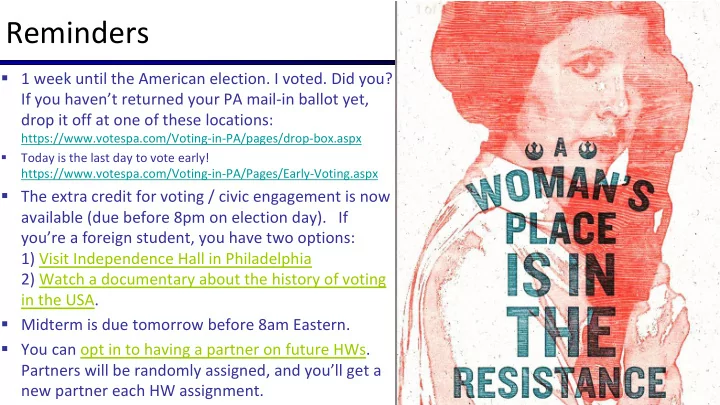

Reminders § 1 week until the American election. I voted. Did you? If you haven’t returned your PA mail-in ballot yet, drop it off at one of these locations: https://www.votespa.com/Voting-in-PA/pages/drop-box.aspx Today is the last day to vote early! § https://www.votespa.com/Voting-in-PA/Pages/Early-Voting.aspx § The extra credit for voting / civic engagement is now available (due before 8pm on election day). If you’re a foreign student, you have two options: 1) Visit Independence Hall in Philadelphia 2) Watch a documentary about the history of voting in the USA. § Midterm is due tomorrow before 8am Eastern. § You can opt in to having a partner on future HWs. Partners will be randomly assigned, and you’ll get a new partner each HW assignment.
Reinforcement Learning Slides courtesy of Dan Klein and Pieter Abbeel University of California, Berkeley [These slides were created by Dan Klein and Pieter Abbeel for CS188 Intro to AI at UC Berkeley. All CS188 materials are available at http://ai.berkeley.edu.]
Active Reinforcement Learning § Full reinforcement learning: optimal policies (like value iteration) § You don’t know the transitions T(s,a,s’) § You don’t know the rewards R(s,a,s’) § You choose the actions now § Goal: learn the optimal policy / values § In this case: § Learner makes choices! § Fundamental tradeoff: exploration vs. exploitation § This is NOT offline planning! You actually take actions in the world and find out what happens…
Detour: Q-Value Iteration § Value iteration: find successive (depth-limited) values § Start with V 0 (s) = 0, which we know is right § Given V k , calculate the depth k+1 values for all states: § But Q-values are more useful, so compute them instead § Start with Q 0 (s,a) = 0, which we know is right § Given Q k , calculate the depth k+1 q-values for all q-states:
Q-Learning § Q-Learning: sample-based Q-value iteration § Learn Q(s,a) values as you go § Receive a sample (s,a,s’,r) § Consider your old estimate: § Consider your new sample estimate: § Incorporate the new estimate into a running average:
Q-Learning Properties § Amazing result: Q-learning converges to optimal policy -- even if you’re acting suboptimally! § This is called off-policy learning § Caveats: § You have to explore enough § You have to eventually make the learning rate small enough § … but not decrease it too quickly § Basically, in the limit, it doesn’t matter how you select actions (!)
Exploration vs. Exploitation
How to Explore? § Several schemes for forcing exploration § Simplest: random actions ( e -greedy) § Every time step, flip a coin § With (small) probability e , act randomly § With (large) probability 1- e , act on current policy
How to Explore? § Several schemes for forcing exploration § Simplest: random actions ( e -greedy) § Every time step, flip a coin § With (small) probability e , act randomly § With (large) probability 1- e , act on current policy § Problems with random actions? § You do eventually explore the space, but keep thrashing around once learning is done § One solution: lower e over time § Another solution: exploration functions
Exploration Functions § When to explore? § Random actions: explore a fixed amount § Better idea: explore areas whose badness is not (yet) established, eventually stop exploring § Exploration function § Takes a value estimate u and a visit count n, and returns an optimistic utility, e.g. Regular Q-Update: Modified Q-Update: § Note: this propagates the “bonus” back to states that lead to unknown states as well!
Regret § Even if you learn the optimal policy, you still make mistakes along the way! § Regret is a measure of your total mistake cost: the difference between your (expected) rewards, including youthful suboptimality, and optimal (expected) rewards § Minimizing regret goes beyond learning to be optimal – it requires optimally learning to be optimal § Example: random exploration and exploration functions both end up optimal, but random exploration has higher regret
Approximate Q-Learning
Generalizing Across States § Basic Q-Learning keeps a table of all q-values § In realistic situations, we cannot possibly learn about every single state! § Too many states to visit them all in training § Too many states to hold the q-tables in memory § Instead, we want to generalize: § Learn about some small number of training states from experience § Generalize that experience to new, similar situations § This is a fundamental idea in machine learning, and we’ll see it over and over again
Flashback: Evaluation Functions § Evaluation functions score non-terminals in depth-limited search § Ideal function: returns the actual minimax value of the position § In practice: typically weighted linear sum of features: § e.g. f 1 ( s ) = (num white queens – num black queens), etc.
Linear Value Functions § Using a feature representation, we can write a q function (or value function) for any state using a few weights: § Advantage: our experience is summed up in a few powerful numbers § Disadvantage: states may share features but actually be very different in value!
Approximate Q-Learning § Q-learning with linear Q-functions: Exact Q’s Approximate Q’s § Intuitive interpretation: § Adjust weights of active features § E.g., if something unexpectedly bad happens, blame the features that were on: disprefer all states with that state’s features § Formal justification: online least squares
Reading Chapter 22 – Reinforcement Learning Sections 22.1-22.5 CIS 421/521 | Property of Penn Engineering | 17
Recommend
More recommend